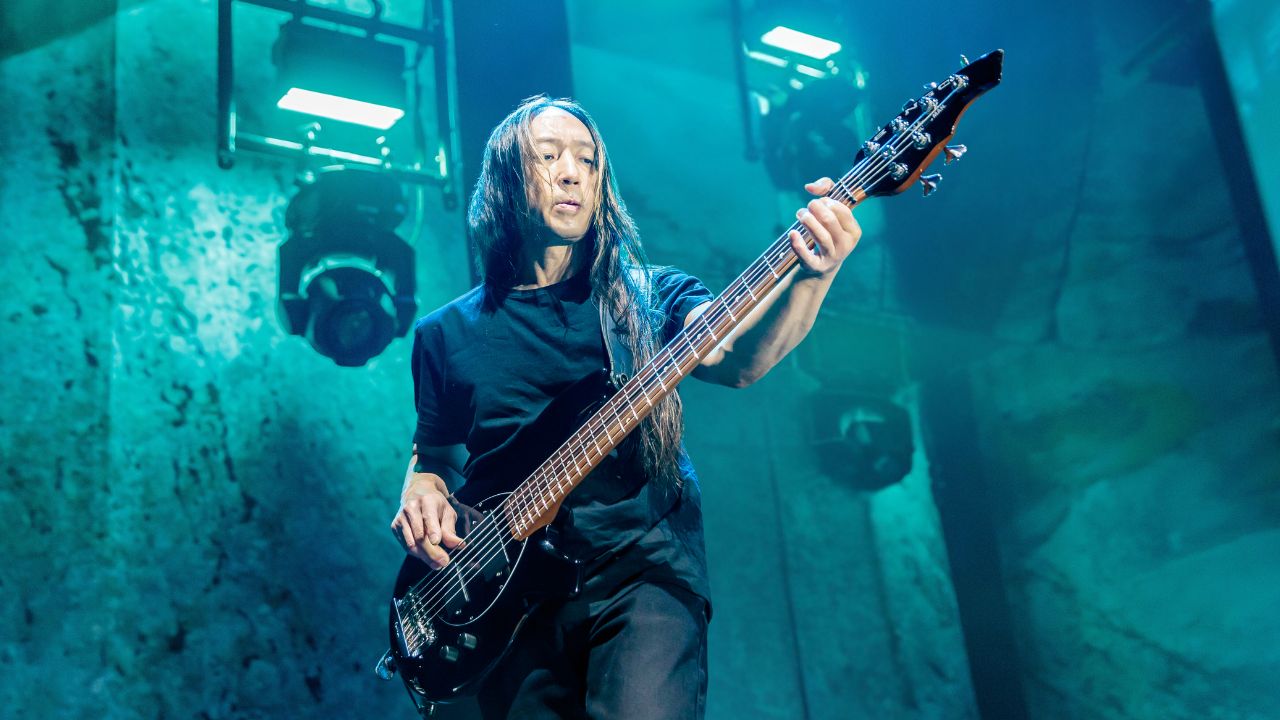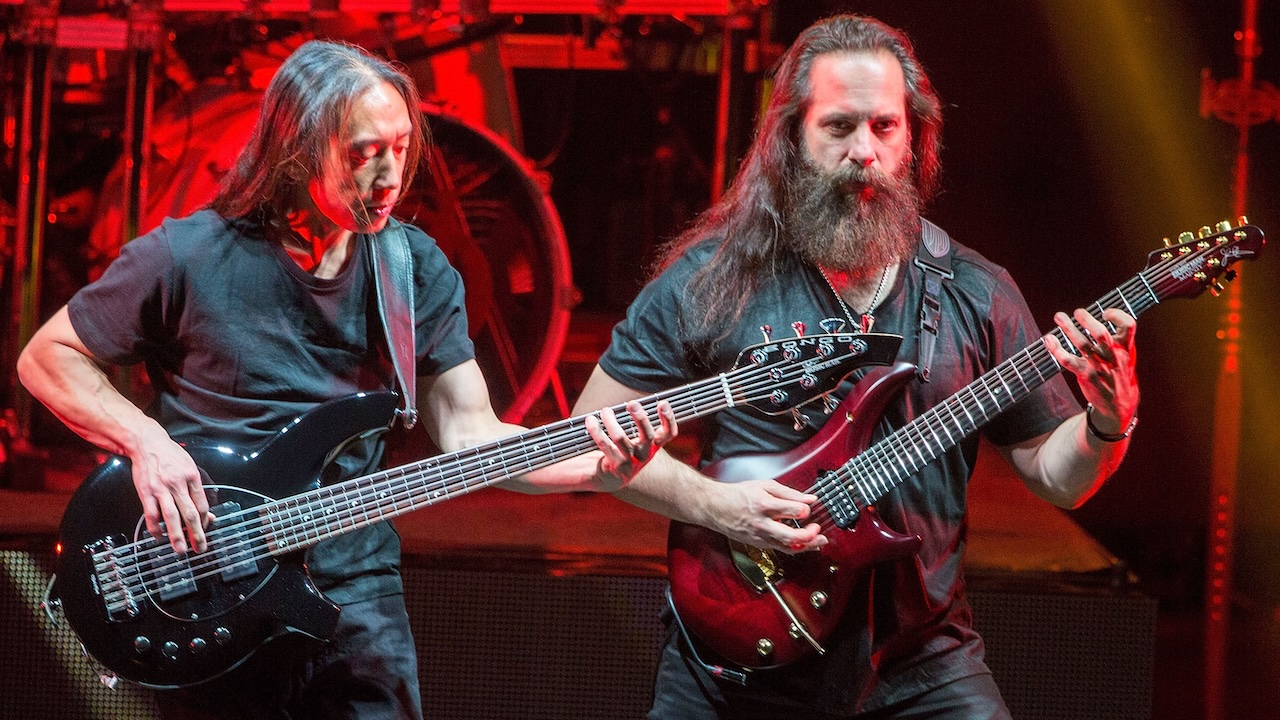
John Myung has been quietly pushing forward the barriers of progressive bass playing for decades with his band Dream Theater, firing off fusillades of notes in perfect unison and counterpoint with his equally dexterous bandmates, and leaving the rest of us open-mouthed in awe in doing so.
Possibly the most technically gifted bassist in the world today, with the arguable exception of Mr Wooten, Dream Theater's founding member specialises in high-speed playing of terrifying complexity, resulting in a barrage of melodic, metallic harmony that has redefined heavy music since the '90s.
Like many a genius, Myung is a quiet, instrospective individual, allowing his bass playing to do the talking, which is a refreshing change in the opinionated world of bass guitar, believe us.
If there's one thing that has come to define him, it's a dedication to craft – and his continuing evolution as a player remains a testament to that fact.
“The key is to identify where you want to go musically, and embrace cool musical values from the past,” Myung told Bass Player. “Understanding the feeling and musicality of Bach's cello pieces, for example, can be great building blocks for future compositions. He was one of the only guys who really understood the range of the bass. All his cello pieces are right in the 5-string bass range.”
“I have a whole collection of Bach stuff and interpretations; it takes six to eight months to get one of the heavier ones together, and that's going at it every day. For me, as a player, there's no lack of things to do. There's only a lack of time.”
Our interview from the Bass Player archives took place in February 2013, following the departure of drummer and founding member Mike Portnoy, and the release of A Dramatic Turn of Events, recorded with drummer Mike Mangini.
Have you changed your approach to better fit Mike Mangini's drumming?
“No, not really. I've just gotten adjusted to his energy. The most important thing about Mike is that everything he does is musical, and he gels really well with the band – that's the key component.”
How do you put together your bass parts in the studio?
“It's sort of like when you're building a big puzzle – you know the piece is in there somewhere, but you need to dig through all the different pieces until you find something that might fit. There's always a moment of wondering.
“Sometimes, it's just a normal sequence of events that builds structure, and other times, it's something that charges the song, like a vibe or feeling – and that conversion of emotion into the song is what makes it what it is. It's great when it works out and takes the song to a new level.”
In This Is the Life, you do a tasty fill at 1:30 in direct response to James LaBrie's vocal melody. Was that improvised or orchestrated?
“I heard that motif as I was recording. There are moments during the overdubbing – or during the actual tracking – that the parts actually develop. That was a moment that developed as I was tracking, not as we were writing.”
Your tone on A Dramatic Turn of Events has a very grinding yet natural sound.
“A lot of that has to do with the valve preamp I was using. James Demeter came across enough parts to build a valve pre that he once made a long time ago. It's the VTMP-2B, the same one Quincy Jones used to record Michael Jackson's Thriller album. It's like the ultimate DI – I love the way it resonated and warmed up the tones, so I tapped into that. It made a big difference.”
You also had some input into the development of the Music Man Bongo 6-string that you're now playing. What impact did that have?
“We went through a few variations. One big improvement was adopting a larger 6-string body style with a 5-string-size neck. The bigger body lends itself to better sound; a thick, heavy body just has a special tone.”

I hear distortion, too.
“I had four tracks in total. One was a Mesa/Boogie Triple Rectifier going through a 4x12 cab for guitar-like overtones. Then I had two other Demeter 2x12 bass cabinets with 8" crossover speaker configurations that were capturing different mic flavors, including a Mojave MA-201fet bass drum mic. There was plenty to work with. But you can always hear the true sound of the bass guitar.”
What's the trick to remembering a song with multiple time changes?
“If I play something enough, I eventually get ownership of the song through physical memory. I tend not to count things much – that's distracting for me.
“There could be something that's felt in triplets, but I'm not really enunciating the triplets; I may just be playing even fours, rather than counting it as groups of three. Or, if there's a 7/8 rhythm and an 8/8 rhythm for a total of 15 beats, sometimes it doesn't matter to me if I count the 7/8 first or the 8/8 first.”
Who inspired your use of Moog Taurus pedals?
“Whenever I would see Rush or Yes live and the bass pedals would kick in, I always loved their power, the impact, and the energy. There's nothing like being able to have that sort of harmony going on in the low-end range.”
“I used them in the chorus of Breaking Illusions, the ending of Outcry, and in the intro and chorus of On the Backs of Angels. It adds an awesome dimension.”
What inspired you to begin playing 6-string bass in the early '90s?
“I recorded the Images and Words album with a Spector 4-string, and after the album was done and we were about to go on tour, several companies approached me about using their instruments. So I started checking out 6-string stuff and really taking to it.
“It made sense for me to venture into that world; it gave me more options. The two extra strings lend themselves to a more creative, chordal type of playing. It was strange at first, but once I got warmed up, it wasn't so foreign anymore.”
“We went straight into writing Awake, and a couple of songs stem from that instrument – the harmonics in Lifting Shadows Off a Dream were inspired by the 6-string. That album represents the transition from 4-string to 6.”
What's your practice regimen like these days?
“I'm working with small trill movements using three right-hand fingers and all four fingers on the left. I have a set pattern in one position, and then I just move it up a half-step each time I do the routine. It usually takes an hour and a half to go fully up the neck.
“That's pretty much what I've been doing for the last couple of years. A consistent, gentle trill movement over a period of time seems to really lock my hands into place and gets me into a frame of mind where I can direct my hands a little more rather than having to ask them. They listen better.”







